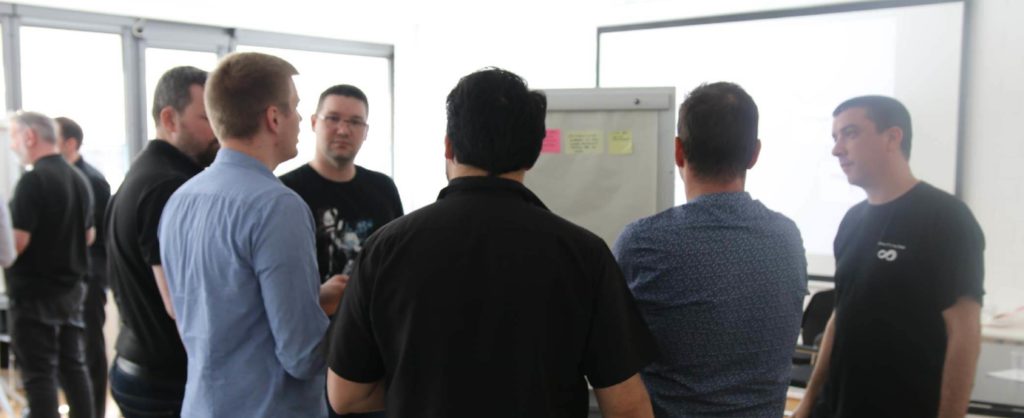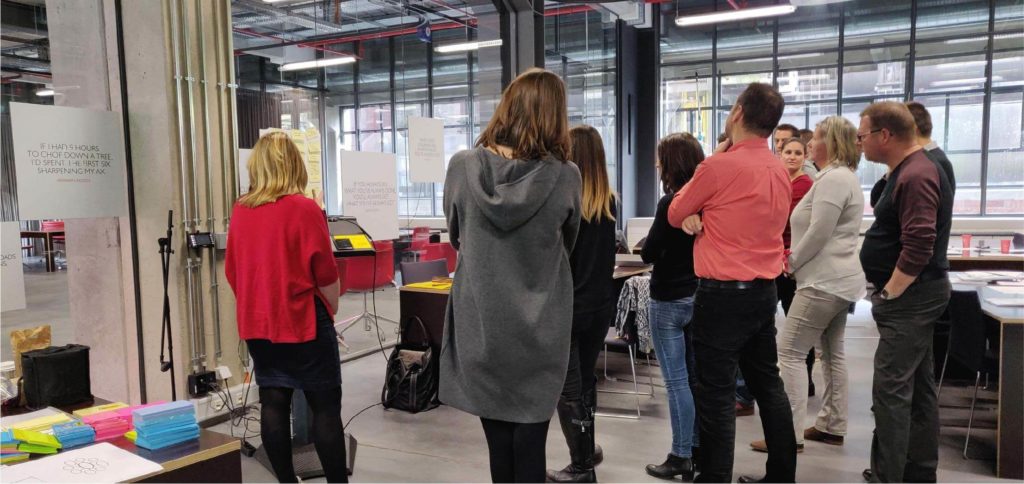Be Agile
Craftsmanship
Product Ownership
The life at AP
How to create a highly performant agile team?
08 Apr 2019
by
Sylvain Chery

Introduction:
A few years ago, you heard about a new way of working: Agile. You saw startups increasing their productivity and engaging their employees at a whole new level. You tried to use these new agile methods and changed your roles, implemented new agile tools, trained the managers and even reorganised the desks in your office. But your teams are still not delivering at the same level of performance as a brand new agile startup!
We find this common situation in a lot of companies, which makes them think "agile is just not working for us". So, we would like to explain the reason why this is happening and what you can do about it.
Myth: "It's because in our context it's different!".
From our experience, although each context is different, agile methods and principles are not limited to only one context. Agile can be applied anywhere, even in non-software companies.

8 reasons why agile is not working for your team
Agile principles and values are not complex to use, but they require a deep understanding of why you want to use them. They require a mindset shift before the use of practices and tools can increase your productivity.
Don't know what are the Agile values and principles? Want an easy way to understand and remember them?
- Doing Agile without understanding why- You use agile because you are expected to, but the reason behind this transformation hasn't been clearly communicated. What will agile bring you? what is your company trying to achieve through this transformation?
- Implementing the tools but not the values- Having wings doesn't mean you can fly. You implemented the tools and the methodology, but people did not change their mindset, and so they don't know how to use them in the right way. Agile is not only about implementing tools, it's about living values and principles in the daily work. Agility is more of an attitude than a toolbox.
- Not measuring outcome- You don't see the benefits of agile because no one defined how to measure them. What are your expected goals for being agile? How can you measure your progress?
- Not using Agile methodologies to adapt- you use agile but you use it to do the same as you did before. You have a roadmap for the next 3 years that is written in stone and no change is allowed, so sad… The market is changing and unless you have some divinatory skills, you roadmap cannot predict all those changes. Agile is designed to help you continuously adapt. Use agile to innovate and to create new products and projects that fit the market of tomorrow not the one from last year.
- Not having a Product Owner- This means that your team receives requests and task assignments from everybody in the company and nothing is prioritised. Feedback from the clients is not taken into consideration and little value is delivered.
- Not embracing Servant Leadership- You designed every detail, you set up the agendas, you checked the individual workload, adjusted the process to be the best … ever.... in the world! But still it is not working! Your team doesn't have enough freedom to be an active part of this plan.
- Not providing an ongoing support- Changing a tool is easy- designing, implementing, training, and providing support is usually enough. But a change in culture is a little bit more sensitive and requires continuous support, coaching and constant communication of a brightful vision from leaders.
- Believing that Agile = Scrum- You tried to implement Scrum, but sadly, it didn't work. No velocity, no predictability, no focus, just a huge mess of developers and users shouting at each other. And the conclusion is: "Agile is not for us". Considering you already cleared the last 7 reasons of failure, maybe you should consider Scrum isn't the most appropriate way of work for your team. The good news is that agile is much more than Scrum! There are plenty of other practices and methods in the Agile world that could still help you.
Book a workshop with us so we can identify what are the reason agile is not working for you, what are your main pain points and how to fix them!

So, what can you do about it?
Don't worry! There are a few things you can do to improve your agile team and fix the reasons they are not delivering as expected.
Clarify the vision
A clear, inspiring and shared vision creates the motivation to get involved in the purpose, the foundation of the organisation. To ensure the success of the company's project, it should be combined with a strong, co-constructed and embodied cultural identity to give it all its power.
In our fast, complex and uncertain environment, agility and cooperation are essential ingredients. Be sure that your vision for the company and for this change is clear, that you know how you will measure the expected results and that you communicate it to everyone involved in the project. You can use different canvas that can help you do that.
Create a new culture
An Agile culture means that employees are valued and that you have mutual respect and understanding. You should give each person the opportunity to explore their true potential.
A learning culture may be the element your company needs to motivate your employees for the long term, especially this new generation of workers who are so eager for innovation and new experiences. The implementation of such a learning culture can contribute not only to their personal development but also to the growth of your organization. There would be more room for innovation, higher standards, as well as higher levels of motivation and engagement within your workforce.
Foster self-organisation and innovation
Teams can't be self organized without support. Many companies think they have self organized teams, because they delegated some decision-making power to the team. However, before starting a project and letting the team organize itself, you need to make sure that your team knows what are the skills of each team member, what is the maturity level of the team, what is their goal and what they need to achieve it successfully. Having self-organized teams is a great performance booster, but it is also a part of a broader and structured approach to empower people in your organization.
Help people embody their new role
Agile methods are based on certain specific roles to ensure maximum balance and performance within teams. If you really want to experiment an Agile approach, setting up those roles according to their design is essential.
- The Product Owner - Driven by passion, she focuses on creating value for customers. She is in charge of the product vision and knows how to prioritize and arbitrates between different needs. She has the trust of the product sponsors.
- The Scrum Master - Unlike a project manager, he is a facilitator, acting with the team as a servant leader. Humble and benevolent, he highlights the team's results while helping it take responsibility for its commitment, without blame or excuses. He is the guardian of the process.
- The Team - The responsibility of the Development Team is to deliver a potentially releasable increment at the end of every sprint. For achieving that goal on a sustainable pace it needs to have all the necessary skills and the appropriate size. An optimal team is small enough to remain nimble and large enough to complete significant work within a Sprint. That is typically between 4 to 9 members. To ease collaboration and enable self-organisation within the team, it is critical to cultivate T-skilled people who have a core competency, in which they are highly effective, and secondary skills that enable them to help or backup their teammates.
- The Manager - As a manager, you should be developing your high-potential people. Start by letting go responsibilities that are repetitive and done daily. Let's say you manage a project or multiple ones. You're likely assigning work to different people, setting objectives, and measuring progress. You might continue to set objectives and goals, but assign someone else the organization of tasks. You can set the metrics by which you will measure performance and success, but let someone else do the measuring, analyze the work and interpret the team's performance. Perhaps the most important part of big-picture thinking is your focus on developing, motivating and inspiring your team members.
Our trainings can help you and your team understand your responsibilities and learn how to perform your role in the best way!
Leverage the team full potential
With a little help, it usually takes only a few weeks for a team to develop its agile capability and start being able to deliver working software on a regular basis. However, to take full advantage of this capability, it is necessary to
- Create a short feedback loop with end-users, and to adapt the plan according to their feedback,
- Create agile interactions between the team and the other parties of the value stream (e.g. implementing DevOps practices with IT operations; sharing data and responsibilities with customer support teams).
Challenge and support the team to continuously improve
Retrospectives are not optional, they are instrumental to the continuous improvement of any agile team's performance, no matter whether it is using the Scrum framework or another approach.
While the collective intelligence inside the team will enable a lot of opportunities for improvement, it is also recommended to provide the team with an external point of view on a regular basis. This can come from participation into external or internal communities of practice, exchanges across teams or agile coaching.
Some improvements can be experimented by the team alone, while other changes, outside the team sphere of influence, require higher-level sponsorship and support for implementation.
Conclusion
You are not alone! Many companies are struggling today to implement agile in their digital transformation. We believe agile is not hard to implement, you just need the right information, mindset and support to get the best out of agile tools and methodologies. We are here to share with you our knowledge and expertise, and to give you tools and good practices so that you avoid big failures and save time. We can support you with various training courses as well as agile coaching. We can also assign agile practitioners to integrate your teams and transfer their knowledge "from the trenches"!
Book a call to discover what\'s the best way to increase your agile team performances!

